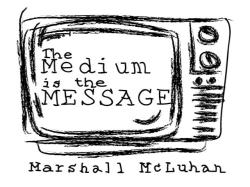 This blog will provide insightful news regarding today’s communication and its influence on society.
This blog will provide insightful news regarding today’s communication and its influence on society.
Gamification or “the application of typical elements of game playing (e.g., point scoring, competition with others, rules of play) to other areas of activity, typically as an online marketing technique to encourage engagement with a product or service” (wikipedia). In order to achieve satisfaction among all players, game creators must take into account the four types of gaming personalities (socializer, killer, achiever,and explorer). I am a killer because I like to kill people (in games of course), and I constantly desire to be the best regardless. My motivation for playing games is to be the top score and have the best equipment to kill other players.
What is cinema? Well, for most, cinema is defined as popcorn, a huge coke, darkness, and a movie. For Manovich, it is defined as the relations between cinema and new media in terms of two vectors; the first being from cinema to new media, and the second being from computers to cinema.
In Lev Manovich’s chapter 6 of “The Language of New Media,” cinema is summarized by two lists. The first list entails the effects of computerization on cinema, and the second summarizes the “distinct qualities of computer-based image.”
According to Manovich, computer media redefines the very identity of cinema. In essence, what use to define cinema (i.e. human actors and movies) are now default options. Which is further described in the archeology of moving pictures. Manovich thoroughly describes the evolution of the still image to the moving image.
Ultimately, Manovich is arguing the cinema is simply a code, and he also reinforces the concept that cinema allows itself to easily be redefined.
In Lev Manovich’s “The Language of New Media,” chapter 5 begins by differentiating between the different types of databases. Databases, or “a structured collection of data for fast retrieval,” use different models to organize data. For example, hierarchal databases are organized in a tree-like structure (p.218). Manovich notes that from the user’s point of view, databases are just another way to retrieve, store, and gather information. In reality, they are much more complex.
Take for instance “virtual museums,” According to Manovich, “a museum becomes a database of images representing its holdings, which can be accessed in different ways” (p. 220). This example is similar to Berger’s series “the ways of seeing.” The museum does not change, it is “moved” from eyes to screen (vice versa). This transition from environment to environment, in some instances, alters our perception of reality. By this, I mean that the paintings and sculptures within the museum lose some of their value when you do not have to physically view it. The images can be everywhere, just like data. We can access information anywhere at any time; this leaves us with a false sense of reality.
Manovich also makes the point that databases represent the world (our information) as lists which cannot be altered. From this, Manovich claims that narrative creates seemingly unordered items (events) (p.225). So, we will always be fighting the databases natural process of ordering items? It is important to realize that humans created the databases, and we could easily re-work them to fit our unorganized lives. When we continue to fit with databases, we are really fighting with ourselves.
To switch gears, Manovich delves into the world of video games. Manovich states, “navigation through 3-D space is essential, if not the key component of gameplay” (p. 245). I found it fascinating that Manovich draws parallels between this ancient form of narrative (video games) and modern literature which are “built around psychological tensions between characters and movement in space” (p.243). Video games have taken hyper-reality to an entirely new level.
This chapter cannot be explained in 300 words, but it was by far my favorite chapter of “The Language of New Media.”
-JMG
Lev Manovich’s chapter four of “The language of new media” illustrates the dynamics of RealityEngine and its influence on illusionism.
Realism, or the ability to simulate any object in such a way that its computer image is indistinguishable from a photograph, differs from simulated reality.
Cinematic realism represents “total and complete representation of reality.” The history of realism in cinema is one of addition. For example, each new technological development reinforces the idea that a previous image is “unrealistic” compared to the present image. This creates a constant state of change in order to keep up with realism. Cinematic style, on the other hand, is of substitution. For example, “if shading or color is put in, perspective can be taken out” (p.187).
Early film expressed realism by over indulging viewers in deep space through various means. During the 1920’s the adaptation of panchromatic “film stock allowed perspective to lose its importance in the production of reality effects in favor of shade, range, and color” (p.190).
It is important to note that cameras record existing reality, but in the case of 3-D computer graphics (realityengine) reality has to be created before it can be recorded.
The need for computer graphics originated from the need for flight simulators and training technology for the military. However, re-creating authentic moving nature is quite a challenge. Smoke, fire, sea waves, and moving grass are just some of the natural movements that SIGGRAPH (a trade show convention for computer animation) has successfully accomplished.
The concern that 3-D synthetic images are not (and will never be) realistic is still an ongoing issue. For example the film “Jurassic Park” used computer simulation for the entirety of the movie, but the legitimate realism was not there. How could it be? Obviously dinosaurs are no longer in existence, and this taints our minds (regardless of perfect animation and graphics) when watching a film or playing a video game.
I am typically a cat person, but a daily stroll through Atlantic Beach made me re-think my feline stance. This dog does not have a care in the world, he is simply waiting for his owner to come back with a tasty yogurt treat. Sometimes I wish I had a simple life, like that of a dog.
-JMG
Jacksonville “The River City” is not simply a metropolis, its home. There are many variations to J-ville; but my favorite includes the beaches, the St. Johns Town Center, and Florida State College. Many feel that Florida is not necessarily the South. However, Jacksonville still maintains a touch of Southern culture because of its close proximity to Georgia (slight twang). Jacksonville is a melting pot. It consists of tourists, natives, millionaires, the homeless, politicians, and of course the Jacksonville Jaguars football team. This city means different things to different people, and this is what it means to me.
 Lev Manovich’s chapter three of “The Language of New Media,” provided a deep stare into the world of real time and telecommunication. This fascinating reality has been the past, is the present, and will be future of interaction between computers and humans (vice versa).
Lev Manovich’s chapter three of “The Language of New Media,” provided a deep stare into the world of real time and telecommunication. This fascinating reality has been the past, is the present, and will be future of interaction between computers and humans (vice versa).
Although the user engages the real time transport, the designer makes teleaction possible through design. But first let’s define what teleaction is exactly; it consists of “acting over distance in real- time,” (p.167). It is important to note that new recording technologies led to the development of arts (such as photography), whereas real-time communication did not.
Manovich describes the act of being “telepresent” by using the example of the film, Titanic where in the opening scene the controller is using a head mounted display that allows him to operate a small vehicle to explore the Titanic on the ocean floor.
Today, the act of being in two places at once has become more familiar. For instance, every time you navigate the web you teleport from one server to another. This allows the user to explore multiple things at a time, and Manovich states that “the ability to explore a multitude of documents located on a computer, from one location, is much more important than being able to perform physical action in one location,” (p. 165).
I agree and disagree with the statement. In today’s world, life is fast. It is necessary to be in two places at once, but I would prefer to slow down and enjoy the environment I am physically in. This includes being able to use my senses, when you are teleporting you are relying on either the computer to do the sensing for you or you are remembering what it was like to smell the beach. If we had never used those senses before, we would not being able to recognize what we were missing. So in a sense, I would either like to teleport or never teleport, but not somewhere in between. Because then I would miss what I did not have (the use of my senses).
These are some of my favorite places to relax on the FSCJ south campus. I encourage you to check them out, but please refrain from bringing large noisy groups of people. This would disrupt the zen vibe.
-JMG
part of the FSCJ Converged Communication baccalaureate program
Going step by step through the world of Converged Communications
The Road to Communication Excellance
904 Shines
The Art and Craft of Blogging
The latest news on WordPress.com and the WordPress community.